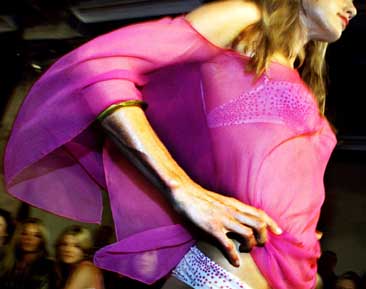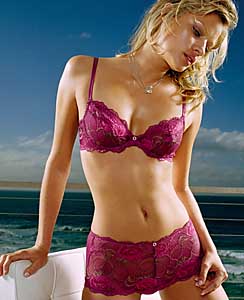

By Laura Demasi - The Sydney Morning Herald
February 11, 2004

Hard sell: Willow on show at Australian Fashion Week 2003. Photo: Brendan Esposito
Lingerie is big business and the main players are spending millions to win new customers.
Forget about the competition between Europe's luxury fashion houses. An equally vigorous battle is being played out in Australia and it has nothing to do with cult handbags or the cut of this season's must-have jeans.
Some of Australia's largest and longest established companies are caught in a $500 million war over your private parts.
In one corner sits the indisputable giant, Pacific Brands, the high end of Australia's intimate apparel world, which owns some of Australia's oldest brands such as Berlei, Bonds, Playtex and Holeproof, which makes Kylie Minogue's signature range.
In the opposite corner sits heavyweight Bendon, one of New Zealand's oldest lingerie brands (now owned by NZ's Pacific Retail Group), which has enjoyed enormous success in both Australia and the UK since it got into bed with Elle Macpherson 13 years ago.
Circling them are other formidable opponents, including the Gazal Group, an underwear empire which includes Oroton Intimate, Kookai, Calvin Klein, Virgin Ware and Lovable.
The industry is very competitive now," says the Gazal Group's chief, Michael Gazal. "It's more competitive than any other category in the clothing industry that I know of. There are many brands out there and only a certain number of customers. Everybody's looking for an edge."
Increasingly, that "edge" is the brand's ability to adapt to the industry's new landscape. Lingerie, you may have noticed, has become a fully fledged member of the fashion establishment. Pretty or "fashion" lingerie is no longer something worn only for special occasions. It has become an everyday staple and women like to update it as often as they update their clothes.
In response, lingerie companies, like fashion houses, design seasonal "collections" based on themes, some with almost as many pieces as your average ready-to-wear clothing range (Bendon's Elle Macpherson Intimates range features more than 100 pieces each season). And many now use glitzy catwalk shows to unveil new collections.
"Things started to change in the mid 1980s," Gazal explains. "Women started to look at lingerie as part of fashion, rather than just a necessity. Now, the people who design lingerie are really fashion designers, they're not just basic underwear designers. They go to a lot of trouble to come up with new fabrics, laces and colours. It's really a fashion business now."
Sue Dunmore, general manager of design and product development at Bendon (which turns over about $120 million a year in Australia, New Zealand and Britain) agrees. "A bra is not just a utilitarian piece of your wardrobe any more. It's a fashion statement."
 With its Elle Macpherson Intimates range, Bendon was one of the
first companies to produce "fashion lingerie" on a mass scale,
making it accessible to millions of women who previously shied away
from the hefty price tags of premium labels such as La Perla. The
reasonable prices allowed women to buy more lingerie, more often and
to see it as an everyday item rather than something just for special
occasions.
With its Elle Macpherson Intimates range, Bendon was one of the
first companies to produce "fashion lingerie" on a mass scale,
making it accessible to millions of women who previously shied away
from the hefty price tags of premium labels such as La Perla. The
reasonable prices allowed women to buy more lingerie, more often and
to see it as an everyday item rather than something just for special
occasions.
"Twenty-five years ago, you had one type of bra you wore all of the time and you only bought a new one when the old one wore out," Dunmore explains. "Now bras mirror fashion trends and you have a bra for every occasion. You wear a certain bra to play sport, another to the office and a different one out to a club."
Now your bra can match your outfit, literally. If you're into this season's bright colours, no doubt you'll find a bra with hot pink straps that work perfectly with your bright yellow singlet top.
The exploding market for fashion lingerie has also given rise to a new generation of boutique, independent labels which, much like the hugely successful boutique denim labels, have filled the gap for niche, "designer" alternatives to the ubiquitous mainstream brands.
One of the brightest in Australia is Willow, designed by Kit Willow. As fashion became more revealing (sheer fabrics, plunging necklines and skinny straps), Willow saw an opportunity to create a new label that was designed to be seen, peeping through straps and necklines, in colours that related to fashion. It was an immediate success, picked up by David Jones in its first season and prestigious UK department store Selfridges in its second.
Willow believes the market for niche lingerie labels will continue to grow in Australia, mirroring international trends. "When you walk into the lingerie area of department stores like Selfridges in the UK, half the floor is devoted to contemporary and independent labels," she says.
Fashion trends not only influence the look of today's lingerie, they have created whole new categories for the industry, increasing the number of pieces and styles in standard ranges, which have in turn increased turnovers.
In the past decade in particular, there has been an explosion in the number of new styles based on what we're wearing on the outside. Our love of tight-fitting T-shirts spawned the best-selling (nipple concealing) contour bra. The ubiquity of the spaghetti strap motivated designers to create the razor back bra, while our willingness to flaunt our cleavages has resulted in all manner of push-up and padded styles. And let's not forget the hipster jeans and pants revolution.
Technology, too, plays a major role in the bra wars. As fabrics and developments in design become more sophisticated, lingerie companies are racing to add "exclusive" high-tech features to their products. "A lot of companies have focused on the fashion side of things," explains Tanya Deans, marketing manager for Berlei. "But the reality is that the majority of the market still wants their bra to fit and support them properly as well as look fashionable. That's where technology comes in."
In 2002 Berlei launched Australia's first seamless bra, followed last year by its "super- tech" sports bra, made from a fabric that contains silver-coated fibres that help control moisture and heat. At about $80, the bra is not cheap but Deans says it has enjoyed healthy sales. "It just goes to show that if a woman finds something that performs well and looks good, she's willing to pay for it," she says.
The marketing of today's lingerie brands is just as crucial as the products themselves. It's now standard practice for lingerie companies to spend millions on television and print advertising campaigns, many of which feature high-profile celebrities who are signed to long-term contracts to be the "face" or "ambassador" of the brand. The strategy seems to be working. Just look at the freshness that Sarah O'Hare and Pat Rafter have lent Bonds over recent years. Berlei is attempting to do the same with its new face, celebrity model Kristy Hinze.
Other companies have relied on sexualised and provocative campaigns to grab our attention. Last year, Elle Macpherson pushed the envelope with her voyeuristic "looking through a keyhole" ads, while Kylie Minogue sexed it up on billboards to promote her latest Love Kylie range.
To keep up with competitors, the Gazal Group spent $1.6 million on the September 2002 relaunch of Lovable, which transformed the brand's girl-next-door image into one more fashionable and sexy. "We realized people were spending a lot of money on marketing and unless we were going to increase the spend significantly, we were going to be left behind," Gazal says.
The company hired The Secret Life of Us actor Samuel Johnson to star in its controversial ad campaign. The most recent TV ads were unveiled late last year, featuring Johnson muttering "great tits" when a beautiful girl dressed in nothing but lingerie wanders into his kitchen. According to Gazal, every cent was worth it; sales have increased. And that, at the end of the day, is what it's all about.
* Expect lingerie to become even more high-tech and, consequently, more comfortable. New fabrics that stretch with the body will allow designers to create bras and knickers that fit like a glove.
* Another strong trend is the return to traditional lingerie fabrics such as satin and washable silks. New high-tech treatments have given these fabrics better stretch and washability than before.
* Expect the trend for ultra-feminine, ornate lingerie to continue. Think embroidery, delicate lace overlays and muted colours. Bright colours will continue to be strong, mirroring fashion's mod/punk mood.
* C cup is the most popular cup size in Australia.
* Thanks to our love of tight T-shirts, the nipple concealing contour bra is an enduring bestseller.
* Underwire bras outsell soft cup styles by far.
* After revolutionizing the underwear business, sales of the G-string are dropping. According to Bendon, "boy legs" are the new G-string and are now the equal bestseller with the standard brief.
* About 60 per cent of lingerie sales occur in the eight weeks leading up to Christmas.
Lingerie Designers we recommend are Shirley of Hollywood, Elegant Moment, Hey Baby, Dreamgirl
More articles that may interest you:
Fit and style tips How to choose lingerie for a gift, how to find your bra size and other important fashion tips
To our valued customers
 New
lingerie, clothing and accessory items are coming in regularly. If you
want to be among the 1st to look at all the latest additions or if you
want to be among the 1st so grab the best sale items join our newsletter
and we'll keep you updated.
New
lingerie, clothing and accessory items are coming in regularly. If you
want to be among the 1st to look at all the latest additions or if you
want to be among the 1st so grab the best sale items join our newsletter
and we'll keep you updated.
We value your Privacy